CMT self-propelled mortar (India)
The development of the CMT project (Carrier Mortar Tracked - “Mortar carrier tracked”) began in the middle of the last decade of the last century. According to reports, the new project had several main objectives. The military wanted a promising self-propelled machine with artillery armament suitable for solving some combat missions. It was necessary to create a new armored vehicle based on one of the existing chassis, which would allow to master the production of the required technology without significant problems. Based on these requirements, by the mid-nineties the terms of reference for the CMT project was formed.
During the development and operation of new technology, the Indian army planned to do without unnecessary costs. For this reason, one of the existing combat vehicles with acceptable characteristics was chosen as the basis for a promising self-propelled mortar. It was proposed to install mortar weapons and other necessary devices on the modified Sarath infantry fighting vehicle chassis, which is a licensed version of the Soviet BMP-2. The use of a finished chassis could provide certain advantages that were supposed to be used in a new project.
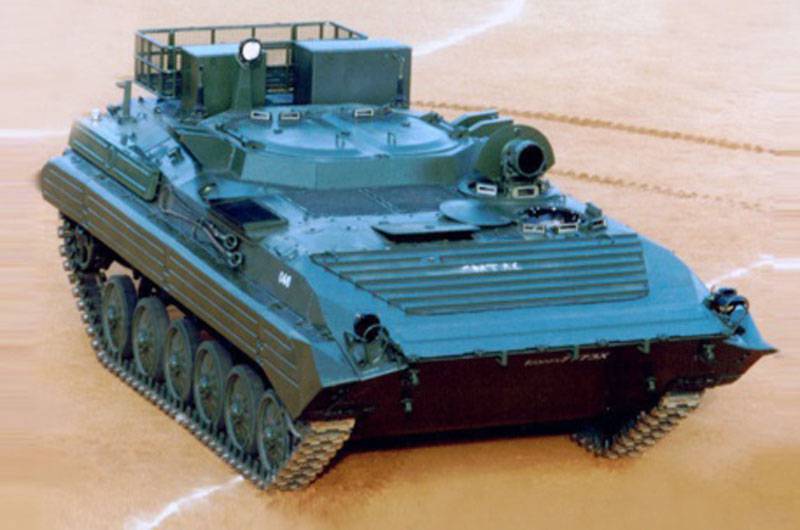
General view of a self-propelled mortar CMT in the stowed position. Photo Aermech.in / size]
The development of a promising combat vehicle was entrusted to leading industry organizations with considerable experience in creating new technology. The authors of the CMT project are the Combat Vehicles Research and Development Establishment CVRDE and the Defense Research and Development Organization (DRDO). Subsequently, several other enterprises were involved in the production of finished equipment, which were responsible for the production and supply of the required components.
For use as the basis of a self-propelled mortar, the existing BMP-2 chassis had to undergo some changes. At the same time, it was proposed to leave part of the units without any modifications. In connection with the installation of new weapons, the Sarakh base infantry combat vehicle was to lose the existing combat and airborne squad. In addition, there is a need to use some new units that are installed on site dismantled.
In the finished form, the CMT self-propelled mortar has a layout that partially corresponds to the base BMP. In front of the hull is located the engine compartment, next to which are the place of the driver and the commander. Behind them is placed surround combat compartment. The troop compartment in the aft of the hull in the new project proposed to use to accommodate part of the special equipment and ammunition.
As in the case of the base machine, the self-propelled mortar is equipped with a body that provides protection against small arms weapons and artillery shell fragments. The characteristic hull lines with an inclined upper front sheet, under which the engine and transmission are located, have been preserved. From the central part of the hull, the CMT project proposed to remove the towers and part of the roof. Instead, they had to mount a low superstructure, which increases the overall height of the fighting compartment. From above, the superstructure received a double hinged hatch, which is used to ensure the use of weapons in a combat situation. In the open position, the doors of the hatch are moved outward and are at a small angle to the horizontal. In the stern of the roof added a set of boxes and mesh basket for the transport of various property. The CMT project provided for the abandonment of embrasures in the stern of the sides.
In its place in front of the hull left a diesel engine, which is a licensed copy of the Soviet UTD-20C1 XHUMX HP With the help of a mechanical transmission, the engine is connected to the drive wheels of the front. After installing all the necessary equipment, the self-propelled mortar surpasses the basic infantry fighting vehicle in combat weight, but this difference does not have a significant effect on the specific power of the vehicle and its mobility indicators. In some cases, for example at parades, the chassis can be equipped with an additional device on the exhaust manifold. Using a curved rectangular tube exhaust gases are discharged from the top of the right side down to the ground.
An existing chassis with six track rollers on each side is used. An individual torsion suspension is used. In addition, the first two and aft pairs of rollers are additionally equipped with telescopic hydraulic shock absorbers. In front of the hull are driving wheels, in the stern - guides. There is a set of supporting rollers. A characteristic feature of the undercarriage of the BMP-2 / Sarath is the presence of special grids on the aft side of the futon shelves, with which they can navigate through the water.
The main goal of the CMT project was to adapt the existing chassis for the installation of a fighting compartment with a mortar of the required type. To do this, it was proposed to remove all unnecessary components from the central part of the body, instead of which the necessary equipment is mounted. Under the body configuration with an opening roof placed rotary installation with fasteners for mortar. The design of the mortar mounting systems is quite simple. The breech of the barrel is fixed on the floor of the fighting compartment with a ball bearing, and the two-leg of the mortar moves along special rails laid in front of the support. This design mount, if necessary, allows you to remove the mortar from the self-propelled chassis and use it as a conventional wearable system. In this case, the CMT carries an additional base plate.
Weapon mounting systems allow you to direct a mortar within a sector 24 ° wide to the right and left of the vehicle axis. Vertical pickup angles vary from 40 to 85 °. Mortar guidance is proposed to be carried out with the help of hand drives. Automation, performing this work, the project CMT is not provided. Mortar allows the barrel to be lowered below the roof for transportation. In the combat position, the muzzle cut rises above the superstructure.
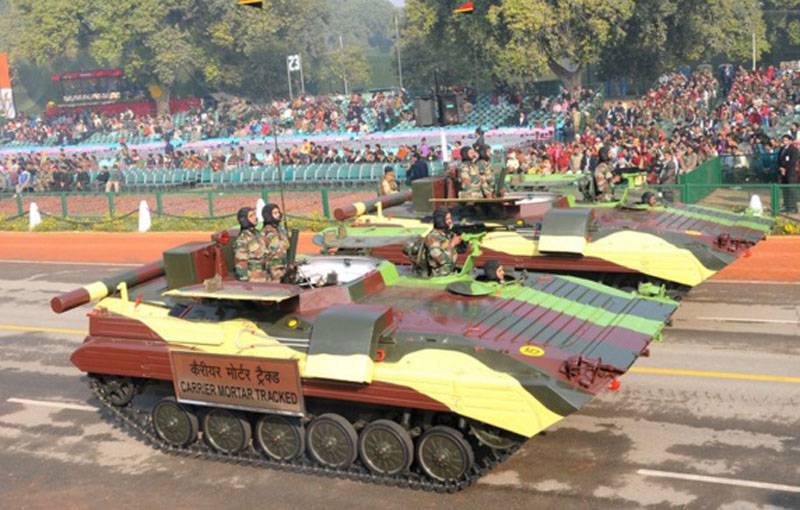
Parade calculation of self-propelled mortars. Photo Aermech.in
The main armament of the CMT is 81-mm muzzle-loading mortar IOF 81 mm Mortar Type 1F. This product is a licensed copy of an Israeli mortar B455. The mortar capabilities allow the use of standard 81 caliber mines of various types. Submission of ammunition into the barrel is carried out manually by members of the crew of a combat vehicle. Mortar characteristics allow you to fire targets at ranges up to 5 km.
In the combat compartment of the self-propelled mortar fits a relatively simple fire control system. The armored vehicle has a set of sensors for determining its own location and calculating the trajectory of ammunition. Using the available digital electronics, the crew can calculate the guidance angles for the weapon, after which they are manually mounted on the mortar's mounting systems. The use of an automated calculation system can significantly reduce the time required to open fire after arriving at a position. Preparation for shooting requires about 30 order. In addition, the electronics can bring the shooting accuracy to a technically achievable limit, limited only by the capabilities of the mortar itself.
Despite the use of manual loader, a trained crew is able to fire at a fairly high pace. The manufacturer declared the possibility of shooting at a steady pace to 6-8 shots per minute. Thus, it becomes possible to create a sufficiently high density of fire for a short time.
The use of a relatively small caliber mortar (most of the modern counterparts of the CMT machine has a 120 caliber weapon), which significantly increased the ammunition load. Inside the fighting compartment and on racks in the former landing compartment, 108 mines of 81 mm caliber were placed. Due to this, a self-propelled mortar can fire for a long time without needing to replenish ammunition.
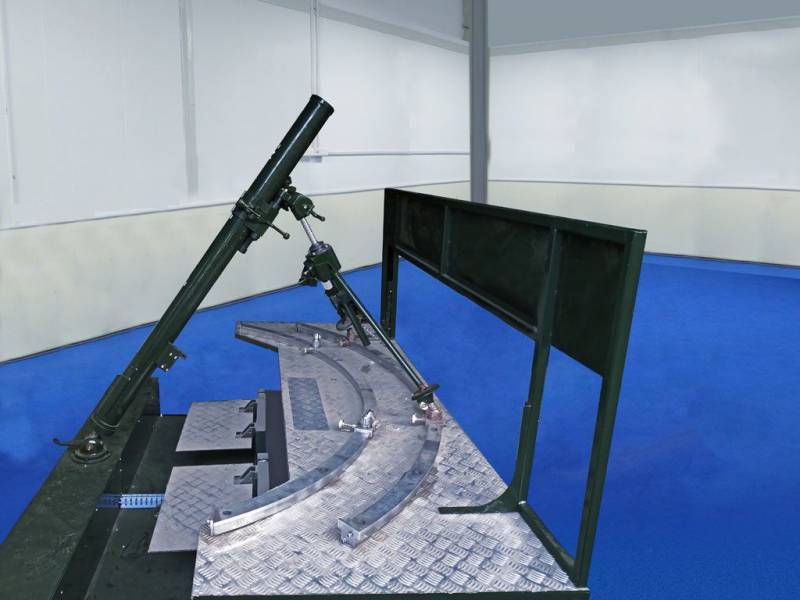
One of the elements of the simulator, designed to prepare mortar. The system design is similar. arming the CMT machine. Photo Zentechnologies.com
For self-defense, a CMT self-propelled mortar must use an X-NUMX-mm IOF MG-6A machine gun. This weapon is mounted on the turret above the commander's hatch. The crew has ammunition in the form of 7,62 cartridges in several tapes. Also, the armored vehicle is equipped with a set of smoke grenade launchers. The crew can use the RCL anti-tank grenade launcher, a licensed copy of the Swedish Carl Gustaf, to fight protected targets. The grenade launcher has ammo in the form of 2350 shots.
The crew of self-propelled mortar Indian development may include from four to six people. In front of the hull, on the left side, the driver and commander are placed. The rest of the crew should be located in the fighting compartment and control the operation of the mortar. For access to their places, the crew has a set of hatches, and it is proposed to monitor the situation with the help of viewing devices. The driver and the commander have their own hatches, manned with several viewing devices, including the possibility of replacing them with night vision devices. To get into the fighting compartment is a large hatch on the superstructure. In addition, the stern doors of the base BMP remain in place. Mortar gunners must observe with periscopic devices installed in the stern of the hinges of their hatch. To improve the working conditions of the crew in difficult conditions peculiar to India, inside the machine there is a tank for drinking water with a capacity of 600 l.
Self-propelled mortar in its size is almost the same as the basic infantry fighting vehicle. The length is still slightly more than 6,3 m, width - 3,15 m, height - about 2,3 m. Due to the installation of a set of new equipment, an armored vehicle with machine-gun armament has a combat mass at 14,5 tons, approximately 500 kg more than its predecessor. Despite the increase in weight, mobility characteristics remain at the level of the base sample. The maximum speed on the highway reaches 65 km / h, on rough terrain - up to 46-48 km / h. Using fuel tanks with a total capacity of 159 l, the cruising range is up to 600 km.
The first prototype of a promising CMT self-propelled mortar based on the Sarath chassis was built in 1997 year. The prototype machine passed the necessary tests, after which it was recommended for use. By the end of the nineties, the Indian industry has mastered the production of new technology. The site for the final assembly of CMT self-propelled mortars was Ordnance Factory Medak in Medak. Soon the army received the first production vehicles of the new model.
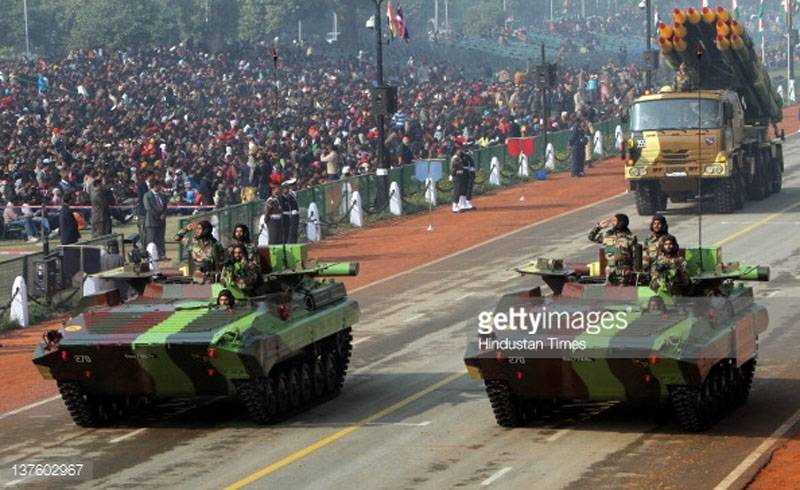
CMT in the parade. Photo Strangernn.livejournal.com
According to various sources, the assembly of serial CMT self-propelled mortars lasted at least until the end of the two thousandth. During this time, troops received at least 220 combat vehicles with 81-mm mortars. It is known that the Indian army currently has more than 5 thousand mortars of 81 mm caliber. Thus, self-propelled vehicles with such weapons account for an insignificant share in the total volume - less than 5%. Nevertheless, the operation of self-propelled mortars such as CMT continues. In addition, some sources claim that such equipment is still being mass-produced and supplied to troops.
The Indian project of the self-propelled mortar Carrier Mortar Tracked was a logical response to the existing challenges, and also proved to be a timely response to the latest trends in the development of artillery systems. Using exclusively existing components, the Indian organizations CVRDE and DRDO managed to develop a curious sample of modern armored vehicles with fairly high performance. The resulting machine was approved by the customer and was adopted for service.
Currently, the Indian Army has at least 220 self-propelled mortars of the CMT type. This technique is operated by the army, as well as regularly demonstrated at parades. Sufficiently successful components of the finished complex, as well as compliance with requirements, allow CMT vehicles to remain in service for a long time. Their service is likely to continue for several more years. In the future, the emergence of new self-propelled mortars of Indian production, including with weapons of increased caliber, up to the standard for modern machines of this class 120 mm, is possible.
On the materials of the sites:
http://aermech.in/
http://pmulcahy.com/
http://zentechnologies.com/
http://strangernn.livejournal.com/
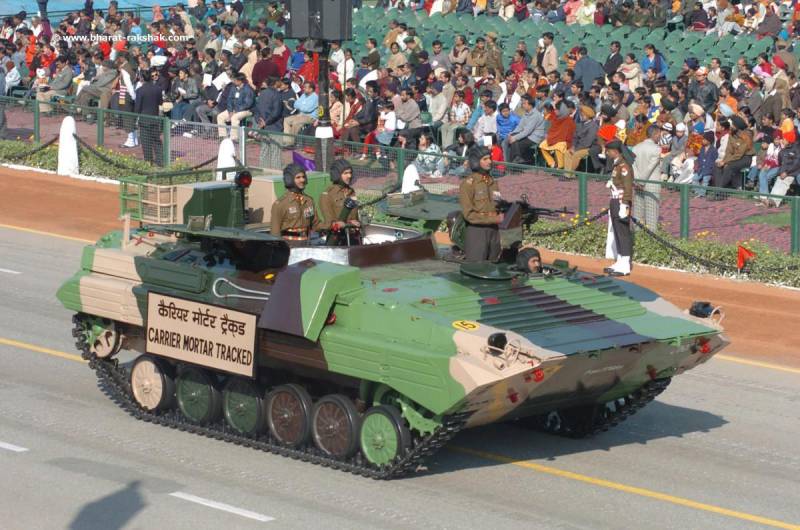
Information